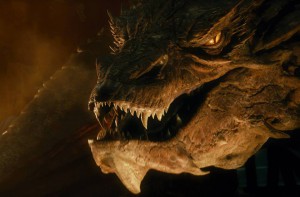 It’s a topical question as the final film of Peter Jackson’s The Hobbit approach: Tolkien emphasises that the bridge over to Lake-town functions as a protection against enemies — and especially the dragon of the Mountain. But why would Smaug need to cross a bridge in order to attack Lake-town? After all, he has wings.
It’s a topical question as the final film of Peter Jackson’s The Hobbit approach: Tolkien emphasises that the bridge over to Lake-town functions as a protection against enemies — and especially the dragon of the Mountain. But why would Smaug need to cross a bridge in order to attack Lake-town? After all, he has wings.
Yet, in a key passage:
Amid shrieks and wailing and the shouts of men he came over them, swept towards the bridges and was foiled! The bridge was gone, and his enemies were on an island in deep water-too deep and dark and cool for his liking. If he plunged into it, a vapour and a steam would arise enough to cover all the land with a mist for days; but the lake was mightier than he, it would quench him before he could pass through. The Hobbit.
We’ve discussed this issue in TORn’s Hall of Fire chats a few times. Personally I’ve always felt Smaug might have been able to land on the Master’s great residence. But not easily, and perhaps not without some risk of ending up in the drink — thus the dragon’s choice to stay aloft and fry everyone from a distance.
In this new piece, Michael Martinez outlines his thoughts on the subject, arguing that “Tolkien felt there was a very strong, perhaps necessary ground-based behavior for dragons”. In addition to the reasons he cites, I wonder whether it isn’t a trait that ultimately harks back to the drakes and serpents of The Book of Lost Tales that crush the gates and towers of Gondolin through weight alone.
Go have a read.


